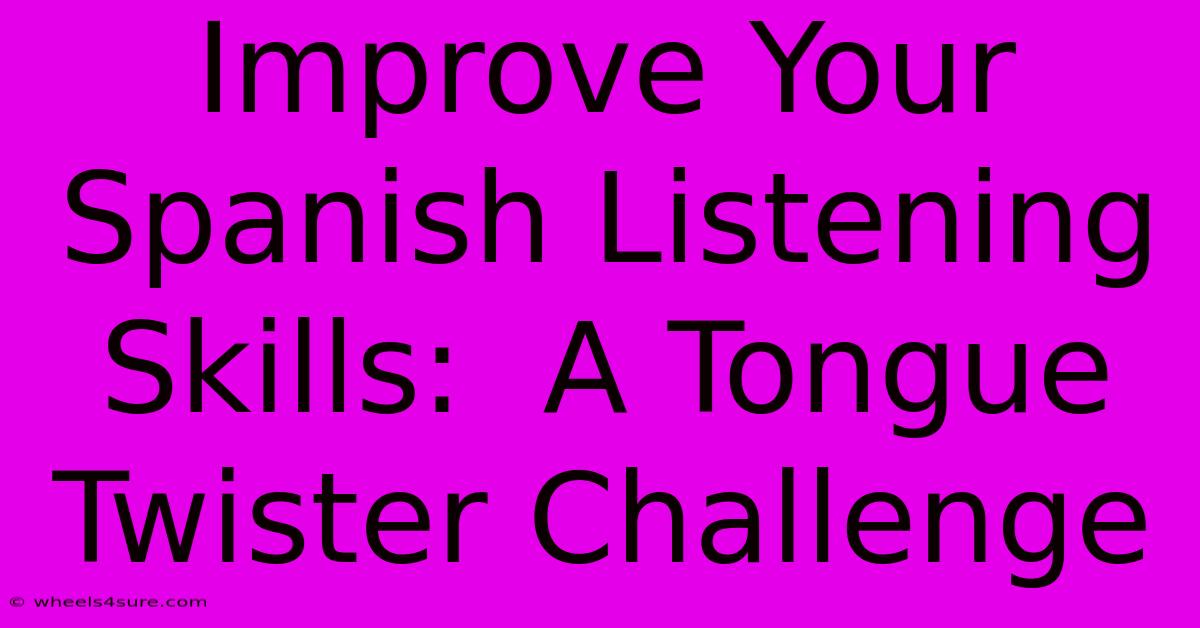Improve Your Spanish Listening Skills: A Tongue Twister Challenge

Table of Contents
Improve Your Spanish Listening Skills: A Tongue Twister Challenge
Learning a new language is a marathon, not a sprint. While grammar and vocabulary are crucial, truly mastering Spanish requires strong listening comprehension. One surprisingly effective method to boost your listening skills is tackling tongue twisters – trabalenguas in Spanish. These playful phrases challenge your ear and force you to focus on subtle phonetic differences, ultimately improving your overall comprehension.
Why Tongue Twisters Work Wonders
Tongue twisters, or trabalenguas, aren't just for kids! They offer a unique advantage for language learners:
-
Improved Phonetic Discrimination: Trabalenguas often feature similar-sounding words and sounds, forcing you to differentiate between them. This sharpens your ability to discern individual sounds within rapid speech.
-
Enhanced Auditory Processing: The rapid-fire nature of tongue twisters improves your ability to process spoken Spanish in real-time. This is crucial for understanding natural conversations.
-
Increased Focus and Concentration: Attempting to repeat and understand a trabalenguas requires intense focus, strengthening your listening concentration.
-
Fun and Engaging Learning: Unlike rote memorization, tongue twisters make learning enjoyable and less daunting. This helps maintain motivation and consistency.
Easy Spanish Tongue Twisters to Get You Started
Start with these beginner-friendly trabalenguas:
Level 1: Simple and Sweet
-
"Pablito clavó un clavito, ¿qué clavito clavó Pablito?" (Pablo hammered a little nail, what little nail did Pablo hammer?) - This focuses on the repetition of "clavito" (little nail).
-
"El perro de San Roque no tiene rabo. ¿Cómo es posible?" (San Roque's dog doesn't have a tail, how is that possible?) - This focuses on the "r" sound and sentence structure.
-
"Tres tristes tigres tragaban trigo en un trigal." (Three sad tigers were eating wheat in a wheat field) - This highlights the repetition of "tri" sounds.
Level 2: Stepping It Up a Notch
Once you've mastered the basics, try these slightly more challenging trabalenguas:
-
"Si quieres ser un buen corredor, corre como un corredor." (If you want to be a good runner, run like a runner.) - This uses similar-sounding words and focuses on speed.
-
"Pepe Pecas pica papas con un pico." (Pepe Pecas cuts potatoes with a beak.) - This focuses on the "p" sound and alliteration.
-
"El ciego se cayó en un pozo, y el pozo se cayó en el ciego." (The blind man fell into a well, and the well fell into the blind man.) – This one plays with word order and rhythm.
Level 3: Advanced Trabalenguas
For those seeking a real challenge, these advanced trabalenguas will truly put your listening skills to the test:
- "Me dijeron que digas que diga que digas que diga que me digas que digas que diga que me digas que diga." (They told me to say that you say that you say that you say that you tell me that you say that you say that you tell me to say.) – This one focuses on rapid repetition and complex sentence structure.
Tips for Mastering the Trabalenguas
-
Listen Carefully: Begin by listening to a native speaker pronounce the tongue twister several times. Pay close attention to the pronunciation of each word and the overall rhythm.
-
Repeat Aloud: Practice saying the tongue twister aloud, focusing on clear pronunciation and correct intonation. Don't worry about speed at first; accuracy is key.
-
Record Yourself: Record yourself saying the tongue twister and compare your pronunciation to a native speaker. This will help you identify areas for improvement.
-
Break It Down: If a tongue twister is particularly challenging, break it down into smaller phrases and practice each phrase individually before putting them together.
-
Be Patient: Don't get discouraged if you don't master a tongue twister immediately. Consistent practice is the key to success.
By incorporating trabalenguas into your Spanish learning routine, you'll not only improve your listening comprehension but also discover a fun and effective way to boost your language skills. ¡Buena suerte! (Good luck!)

Thank you for visiting our website wich cover about Improve Your Spanish Listening Skills: A Tongue Twister Challenge. We hope the information provided has been useful to you. Feel free to contact us if you have any questions or need further assistance. See you next time and dont miss to bookmark.
Featured Posts
-
The Most Reliable Nuevo Laredo Time
Apr 03, 2025
-
Kim Soo Hyuns Net Worth Facts Vs Fiction
Apr 03, 2025
-
Age Of Mythology Hile Your Path To Victory
Apr 03, 2025
-
David Hasselhoffs Net Worth Beyond The Headlines
Apr 03, 2025
-
Reborn A Fathers Unwavering Duty To Protect
Apr 03, 2025
